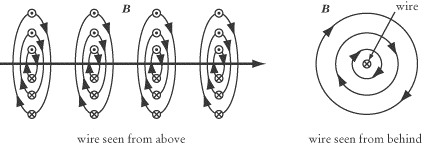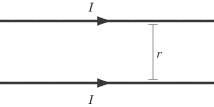Lesson: Chapter - 15
The Magnetic Field Due to a Current
So far we have discussed the effect a magnetic field has on a moving charge, but
we have not discussed the reverse: the fact that a moving charge, or current,
can generate a magnetic field. There’s no time like the present, so let’s get to
it.
The magnetic field created by a single moving charge is actually quite
complicated, and is not covered by Physics. However, the magnetic field
created by a long straight wire carrying a current,
I, is relatively simple, and is fair
game for Physics. The magnetic field strength is given by:
B = µ0I/2pr
Video Lesson
The constant
µ0
is called the permeability of free space, and in a vacuum it has a value
of about
4p × 107 N/A2.
For Physics, it’s not important to memorize this equation exactly. It’s
more important to note that the strength of the magnetic field is proportional
to the strength of the current and is weaker the farther it is from the wire.
The direction of the magnetic field lines are determined by an alternate version
of the right-hand rule: if you held the wire with your thumb pointing in the
direction of the current, the magnetic field would make a circular path around
the wire, in the direction that your fingers curl.

Example

Two parallel long straight wires carrying a current I stand a distance
r apart. What force does one wire exert on the other?
Consider the magnetic field created by the bottom wire as it affects the top
wire. According to the right-hand rule, the magnetic field will point out of the
page, and will have a strength of B
= (µ0 I)/(2pr).
The force exerted by the bottom wire on the top wire is
F = IlB. If we substitute in for
B the equation we derived above, we
find the force per unit length is:

Using the right-hand rule once more, we find that the force pulls the top wire
down toward the bottom wire.
We can apply the same equations to find that the top wire pulls the bottom wire
up. In other words, the two wires generate magnetic fields that pull one another
toward each other. Interestingly, the fact that each wire exerts an opposite
force on the other is further evidence of Newton’s Third Law.
Next to display next topic in the chapter.
Practice Questions
Video Lessons and 10 Fully Explained Grand Tests
Large number of solved practice MCQ with explanations. Video Lessons and 10 Fully explained Grand/Full Tests.